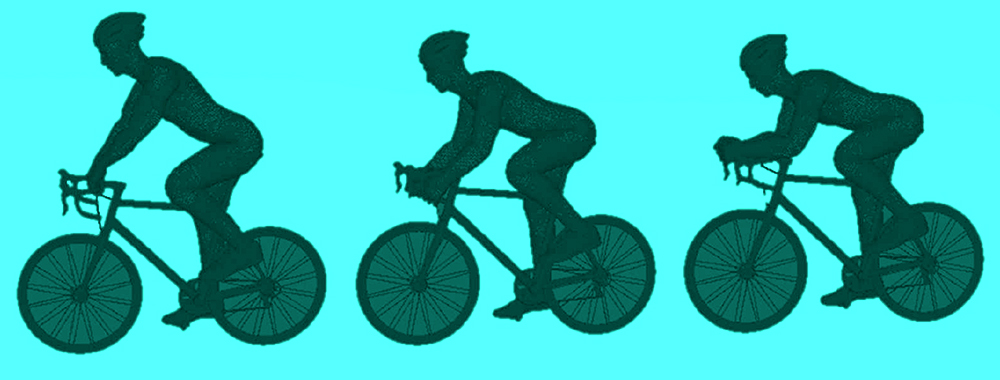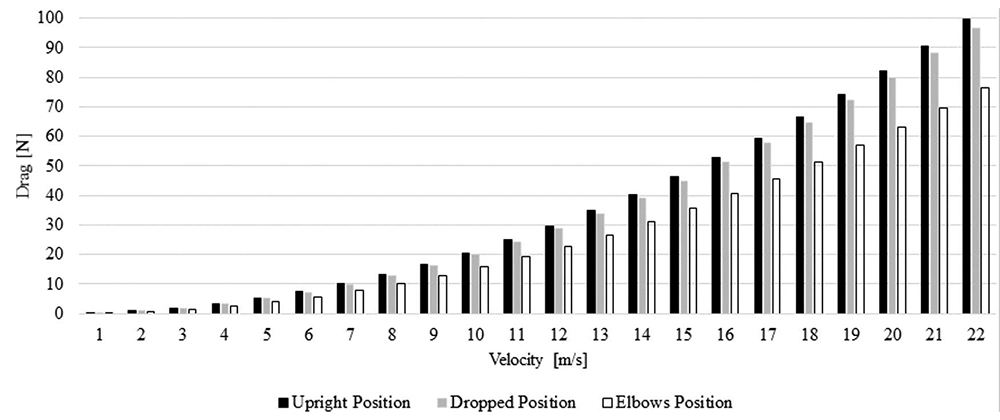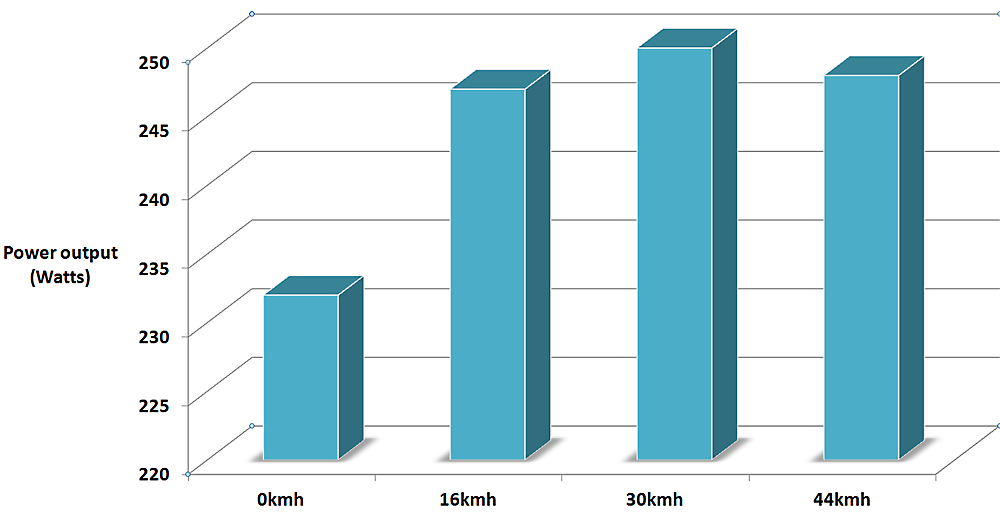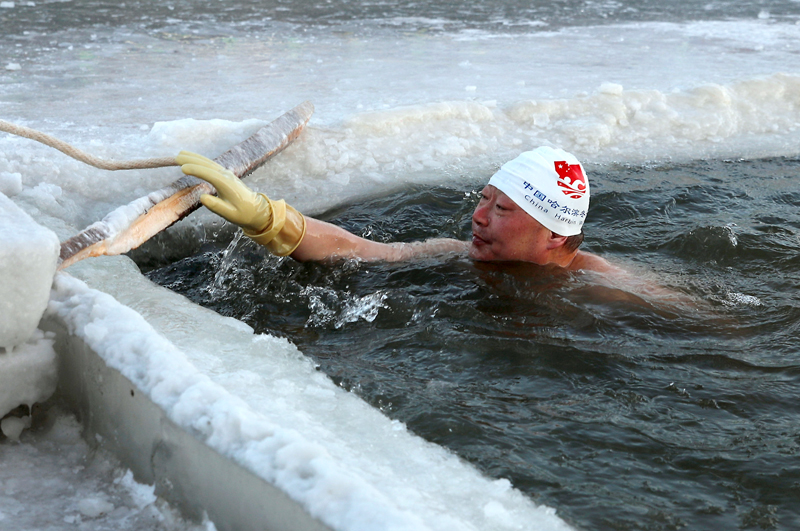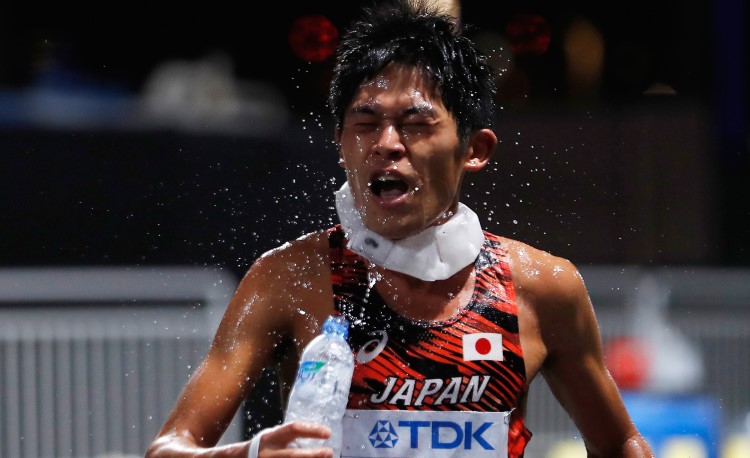You are viewing 1 of your 1 free articles. For unlimited access take a risk-free trial
Heat of the moment: can wind be a cyclist’s friend?
SPB looks at new research on hot weather cycling and explains why the bane of cyclists – the wind - can be sometimes be your friend
As all cyclists will (or should!) know, most of the energy expended on the bike is required to overcome wind resistance. An aerodynamic (low) riding position that minimizes wind drag is therefore critical to performance. To give you an idea of just how important the impact of wind resistance is, a study carried out by Portuguese scientists investigated the impact on aerodynamic drag and energy expenditure when riding upright (high wind drag), on the bar tops (moderate wind drag) and riding on the elbows in a time-trial position (lowest wind drag - see figure 1)(1).
Figure 1: Aerodynamic analysis of the three riding positions
What they found was that the effective surface area of the rider (ie the surface area interacting with wind resistance as the rider moves through the air) was 0.332 sq metres in the upright position and 0.327 sq metres in the dropped position. However, when riding on the elbows, this dropped to 0.261 sq metres – a big improvement in aerodynamics. As you can see in figure 2, this had a profound effect on wind drag, especially at higher speeds where the tucked-in elbows position resulted in far less drag through the air then either of the other two positions.
Figure 2: Drag (resistive force in Newtons [N]) at different velocities in the three riding positions
Using some simple maths, at 25mph (11m/s), the drag holding back the cyclist riding on the bars is around 25 Newtons. A Newton of force exerted over a metre of distance = 1 joule; therefore, the cyclist has to expend 25 joules of energy per metre to overcome this drag. And since the speed is 11 metres per second, this means the rate of energy use (power) is 25 x 11 joules per second = 275 watts. Remember, this is the power just to overcome wind resistance, and doesn’t take into account the power to overcome rolling resistance on the road, mechanical losses in the drivetrain and of course the force of gravity if the cyclist is gaining height.
Given these facts, it’s hardly surprising that headwinds and even crosswinds are considered the bane of cyclists’ lives! Not only do headwinds increase the power demand to maintain a constant pace, research also shows that both headwinds and tailwinds result in more power variations and a less even pacing strategy compared to calm conditions or tailwinds, neither of which is conducive to a PB(2,3). You might assume therefore that calm conditions will always lead to the fastest cycling times, right? Not quite. Because there’s another factor at play in this equation – heat.
Heat stress
A sustained and prolonged power output of 275 watts is hard work – even for a fit rider. However, the wind cooling effect on the body at those kinds of speeds (around 25mph on the flat) is considerable. But what if the route you’re riding is not flat and you’re riding on a hot day? In particular, what happens if you have to tackle a longer climb?
Your workload is likely to increase, which results in more heat production. But at the same time, your speed will drop dramatically. On a modest 8% gradient working (hard) at 300 watts, you’ll struggle to hold even 10mph. This lower speed dramatically reduces the wind cooling effect, so the body tries to compensate by increasing the rate of sweating - lost fluid that has to be replaced.
Moreover, the attendant rise in the body’s core temperature will make it harder to sustain the work rate. Indeed, one study found that just 16.5 minutes of simulated climbing in hot conditions was enough to raise core temperatures by nearly 1C, resulting in 16% less power, higher heart rates and much higher rates of perceived exertion(4).
In these hot conditions, can the extra cooling benefits (and therefore lower thermal stress) of a windy environment compensate for the extra energy required to cut through that wind? In other words, could it be advantageous for cyclists tackling a climb to perform it in windy conditions? If so, how much wind is needed to provide a beneficial extra cooling effect, and at what wind speeds are the cooling advantages outweighed by the aerodynamic disadvantages?
To date, there’s been little research on the cooling and performance effects of wind blowing while cycling. That’s perhaps understandable since the assumption has always been that cyclists don’t need to worry about wind cooling as they generate a cooling breeze while slicing through the air, even when ambient conditions are completely calm. But is that really the case?
New research
To try and answer this question, a tea of Australian scientists has just published new research investigating the effect of different air velocities on heat losses and performance during prolonged self-paced exercise in the hot conditions(5). Published in the journal ‘Medicine & Science in Sports and Exercise, this study examined the performances of trained cyclists who had to complete a ‘total workload’ time trial involving the expenditure of 700kJ of energy in temperatures of 32C (90F) and 40% humidity. The time trial was set at a total amount of work rather than distance because the researchers wanted to ensure that each cyclist completed the same amount of work in each time trial.
On four separate occasions, 12 cyclists each completed a 700kJ time trial in 32C (90F) temperatures. However, the four trials varied according the simulated ambient wind speed during the trial. These were:
· Calm (0kmh/0mph)
· Light breeze (16kmh/10mph)
· Moderate wind (30kmh/18.5mph)
· Strong wind (44kmh/27.5mph)
During each time trial, the cyclists’ performances were monitored – principally how much power they were able to sustain through the time trial. In addition, thermal, cardiovascular and the cyclists’ heat perception responses were measured. Also, the researchers measured the heat balance of the cyclists by determining how much heat they were generating and how effectively they were able to lose that heat. As part of this measurement, the maximum potential for sweat evaporation from the skin (Emax) was calculated.
What they found
The first find was that when the wind (simulated by a fan) was calm, the average power output of the cyclists in the time trial was significantly lower (232 watts) compared to the 16, 30 and 44kmh wind speeds, where average power output was 247, 250 and 248 watts respectively (see figure 3). The second finding was that the average power outputs correlated well with the heat losses from sweat evaporation (Emax) from the skin. Measured in heat loss units of watts per square metre (W/m-2), Emax was lowest in the calm condition at 160W/m-2, rising to 298W/m-2 at 16kmh, 313W/m-2 at 30kmh and 324W/m-2 at 44kmh. The low cooling effect in calm conditions was reflected in core temperatures, which average 39.4C in the calm condition compared with 39.0, 38.8 and 38.8C in the 16, 30 and 44kmh trials respectively.
Figure 3: Effect of ambient wind on average cycling power
Compared to riding in calm conditions, power output was significantly higher when ambient winds were present, regardless of the speed of those winds. The drop in power output was almost certainly related to the poor evaporative cooling in calm conditions compared to all three conditions in the wind!
Finally, it was clear that the calm conditions had a negative effect on heart rates and perceived efforts, with the calm air time trial requiring a higher work rate and higher levels of perceived effort despite the power output being significantly down on the other three time trials in the wind.
Implications for cyclists
Although wind is universally considered as a ‘bad thing’ for time trial performances, this study shows that when it’s hot, things are not quite so simple. If you’re cycling outdoors in hot weather in completely still air, you will of course get the benefit of wind cooling as you slice through the air. Any air flow created by riding above 16kmh/10mph (a speed that any competent cyclist can maintain on the flats and during gentle gradients) seems to deliver significant benefits.
But what if there’s a tailwind during your ride? Here of course, you will benefit from the drop in wind drag (as the air is moving with you), so your speed will be faster for any given power output. However, the downside is that the very beneficial cooling effects of the wind will be reduced, which means that thermal strain is increased. Over a short distance, this is unlikely to present a problem, and neither is it a problem in a solo or training ride. However, in a longer race or time trial against other cyclists, the thermal strain may begin to have an impact on how well you perform compared to others. Given that a tailwind gives all competitors the same reduced drag advantage, your ability to tolerate thermal strain will play a much more important role. In this case, the use of cooling techniques is worth considering (see this article).
If you’re facing a long climb where speeds are low (under 16kmh) and where there is a slight headwind, you can take heart. A slight headwind combined with a low climbing speed will result in a good cooling effect, which will help lift your power output and reduce perceived exertion. Psychologically therefore, you shouldn’t feel disheartened when experiencing that headwind as you get into your climb; a small headwind could actually improve your performance!
The same goes for a crosswind, which provides an ideal combination of increasing cooling in the heat without a significant increase in wind drag (although there is a small penalty from crosswinds in this respect). If you’re climbing with a slight tailwind in hot weather, you need to accept that you will pay a heat penalty. As mentioned above, for short climbs under 15 minutes or so, this shouldn’t cause too much problem. However repeated short climbs, or a longer climb with a tailwind will be more taxing. The key here is to adjust your pacing accordingly and ensure you stay well hydrated at all times, taking extra fluid stops if needed (see this article by Professor Ron Maughan).
Finally, it should be apparent that when training indoors on the rollers or stationary bike, decent cooling provided by a fan capable of producing a constant airflow of 16kmh/10mph or more is a must. You will stay cooler, feel more comfortable and perform significantly better!
References
1. Front Bioeng Biotechnol. 2020; 8: 538
2. Med Sci Sports Exerc. 2006 Apr;38(4):726-34
3. Ergonomics. 2000 Oct;43(10):1449-60
4. J Appl Physiol. 2015 May 15;118(10):1258-65
5. Medicine & Science in Sports & Exercise ():10.1249/MSS.0000000000003168, March 27, 2023
Newsletter Sign Up
Testimonials
Dr. Alexandra Fandetti-Robin, Back & Body Chiropractic
Elspeth Cowell MSCh DpodM SRCh HCPC reg
William Hunter, Nuffield Health
Newsletter Sign Up
Coaches Testimonials
Dr. Alexandra Fandetti-Robin, Back & Body Chiropractic
Elspeth Cowell MSCh DpodM SRCh HCPC reg
William Hunter, Nuffield Health
Keep up with latest sports science research and apply it to maximize performance
Today you have the chance to join a group of athletes, and sports coaches/trainers who all have something special in common...
They use the latest research to improve performance for themselves and their clients - both athletes and sports teams - with help from global specialists in the fields of sports science, sports medicine and sports psychology.
They do this by reading Sports Performance Bulletin, an easy-to-digest but serious-minded journal dedicated to high performance sports. SPB offers a wealth of information and insight into the latest research, in an easily-accessible and understood format, along with a wealth of practical recommendations.
*includes 3 coaching manuals
Get Inspired
All the latest techniques and approaches
Sports Performance Bulletin helps dedicated endurance athletes improve their performance. Sense-checking the latest sports science research, and sourcing evidence and case studies to support findings, Sports Performance Bulletin turns proven insights into easily digestible practical advice. Supporting athletes, coaches and professionals who wish to ensure their guidance and programmes are kept right up to date and based on credible science.

